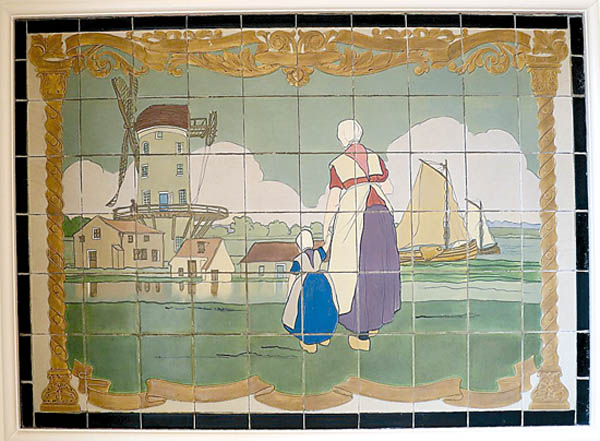Rookwood Pottery And Tiles
Fooled By Fakes
As Rookwood moved through the decades and included popular styles of each period, they also introduced new glazes, including Matte, Standard, Vellum, Iris, Sea Green and more. A rare early glaze that was used only for a short time because of its instability was Tiger Eye, which is recognizable by its gold streaks.
Until 1905, each piece was crafted and painted by artists; then mass production was introduced, so no more pieces contained artists' signatures. Rookwood sales suffered during the Depression, WWI and WWII, and they finally stopped production in 1967. Then in 1982, as the company was about to be sold to a manufacturer overseas, an American art pottery collector purchased Rookwood. Production was limited to small amounts of pottery using original trademarks. Rookwood was sold once again in 2004, and production was moved back to Cincinnati, Ohio. As of today, Rookwood Pottery Company is in full swing using original molds and glazes with updated equipment. The company is once again "forward-thinking," working with top artists to create high quality products and getting lots of positive attention.
With new Rookwood pieces made from old molds currently in production, it could be confusing to determine whether a piece for resale online is new or old, or possibly an unauthorized copy. This is where the mark plays in important part - most old Rookwood contains one of three marks: Rookwood, R and P reversed, and the RP mark with flames. However, there are lesser-known marks, including an incised or painted RPCOMLN, a rare anchor stamp, raised ribbon or banner stamp (1882), an impressed kiln (1883) and a few others. New marks only use the RP mark with flames, but the production year is written in Arabic numbers, whereas old pieces used Roman numerals. Secondly, the mark in the old pieces was impressed into the clay, whereas the mark is etched into the glaze in the newer pieces.
Authentic Rookwood pieces have marks any collector can research and decipher; you'll find marks related to glaze and material type as well as size, date and shape identification and more, including trial pieces. A light "X" was scratched into "seconds" that have flaws (sometimes very minor), but oddly, some unflawed pieces are also marked with an "X." The long-standing explanation is that because seconds were less expensive when new, some unscrupulous people hand-marked pieces they wanted with an "X" in order to demand a lower price. So don't just go by the mark, check the piece carefully for flaws - or lack thereof.
There are many copies of Rookwood pieces that have been made straight from the vintage originals that have no copyright protection. One of the rarest Rookwood tiles is the rabbit tile, which naturally makes it a target for copies. Most of these reproductions have only paper labels that are easily removed, but some companies do mark their tiles superficially. However, most of stamped marks can also be removed by scraping or chemicals; no one would want to remove an authentic Rookwood mark, so if you see a scraped, filed or otherwise altered area on the back, another maker's mark has been removed. In other cases, the tile may have had some type of backing applied to it or it may be framed, which would prevent potential buyers from seeing whether the tile has a true Rookwood mark. If the piece is marked and priced as authentic Rookwood, make sure to see the back before buying.
Sloppy-looking Rookwood marks are usually a good sign of a fake; many times, these poorly made marks are on one-of-a-kind pieces, which are typically fakes and have no year or model number. Small details, like the tiny hook shapes at the end of the flame mark, are usually missing on fake pieces.
Collectible in their own right but not considered Rookwood are unfinished pieces that late-19th century women would buy as blanks, then paint at home. Although the bodies of these pieces were made by Rookwood, the hobbyists who painted them were not Rookwood artists, so the pieces are not classified as authentic Rookwood. (Ironically, the woman who founded Rookwood, Maria Longworth Nichols, was herself a hobbyist who enjoyed painting ceramic blanks.)
Photos via Wikimedia Commons.
At A Glance:
Signs of a copy or fake:
1. Mark incised into glaze
2. One-of-a-kind pieces should raise a red flag
3. Sloppy marks
4. Missing model number
Reference books, websites and collecting groups are the best ways to keep from being fooled by fakes. Here are a few: Rookwood Pottery: Identification and Price Guide by Denise Rago and Rookwood Pottery Company (www.rookwood.com).








